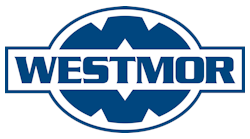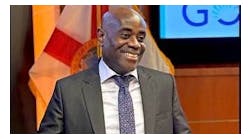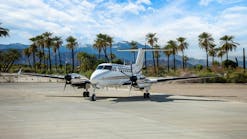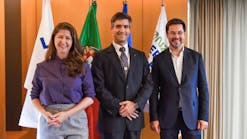At the end of March, the general aviation community will come together in Las Vegas for Aviation Industry Expo, comprised of the AS3, the National Air Transportation Association (NATA) and Professional Aviation Maintenance Association (PAMA) annual conventions, and GSExpo. James Coyne, NATA president speaks with AIRPORT BUSINESS about the upcoming convention, the issues that the organization’s members are facing, and some of the speakers that will address those issues head on. Plus, an update on what to expect at AIE and a conversation with NATA’s Stephen Beaulieu on the recent fuel tax change.
In early February, the White House released its budget proposals for 2007, which were disappointing to Coyne. “They abolished funding for general aviation airport programs; they dramatically cut back on a lot of the funding for the staff that we need to insure that there’s the manpower at the FAA to do the job that they’ve got to do; and, of course, there’s the adminstration’s expected introduction of a user fee proposal sometime in the next month.”
NATA strongly opposes a user fee-based system. Coyne says the proposal will negatively impact general aviation by a drop in use as much as 20 to 30 percent. “Perhaps even more because they haven’t told us how big the fees are going to be.”
“If you believe Jim May, the president of ATA [Air Transport Association], his view is that it should cost the same for the government to handle, in terms of air traffic control, a one-passenger turboprop as it costs to handle a 500-passenger Airbus 380. And he feels that both planes should be charged the same amount.”
Coyne adds that user fees could very well drive the middle class out of private aviation, leaving only the “very, very wealthiest people — and even they will be discouraged just by the hassle factor of all this extra billing and costs.”
Of equal concern to NATA and Coyne is FAA cutting money to the improvement of the nation’s airports. “You can’t just cut back to zero support for general aviation airports and expect those billions of dollars of infrastructure to be properly up to date,” he says.
The annual convention will allow NATA to present these issues to its members and encourage them to contact their Congressional members to oppose the proposed budget.
Industry Challenges, Not All Bad News
Other top issues, according to Coyne, include ...
- taxation of fuel use (see sidebar);
- environmental issues, including the Spill Prevention Control and Countermeasure (SPCC) Rule;
- safety at all times in aviation;
- regulations that affect the charter industry — especially the “paperwork nightmare” for operators;
- the flight training community suffering from TSA regulations, particularly for foreign students; and
- maintenance challenges, in light of FAA scaling back manpower needed to approve maintenance work and STCs.
Coyne says there is good news, however. “The industry is probably more dyanamic now than I’ve ever seen it,” he says. With the introduction of new capital, new products like very light jets (VLJs) and the announcement of recent mergers and acquisitions, the industry is growing and becoming stronger. He estimates that 2005 was the biggest year ever in terms of new capital coming into the industry.
More and more, says Coyne, the public wants the benefits of personal aviation, and the industry is reacting to this change. “Public demand for what our businesses do has grown to unprecedented levels. And I think the only real worry that we all have is what government might do to us.”
NATA continues to encourage airports to lengthen the terms of leases so that airport tenants can borrow money effectively for capital improvements. Explains Coyne, “The whole thing is driven by the realities of the financial marketplace where, in order for us to borrow money to build something, we need a long-term lease.”
While proposed legislation calling for 75-year minimum leases did not make it through the U.S. House, Coyne says there is continued hope that Congress, as it moves forward in the reauthorization process for FAA, will include language which emphasizes the importance of long-term leases for airport tenants.
“We don’t want 75-year leases just because we like the number 75,” says Coyne. “We essentially want to ensure that the investors and owners of aviation businesses can go out and arrange for long-term mortgages and raise the capital that’s needed for improving their facilities.”
DCA, Security
The National Air Transpor-tation Association continues its work to improve access to Reagan National Airport (DCA). “The DCA proposal they came up with was, as we suspected, totally unrealistic long term,” says Coyne. He expects that near the end of March, NATA will submit to the Transportation Security Adminstration a report on the first six months of the new procedures for access to DCA and how it’s not working, as well as suggestions for reform.
Coyne says the current TSA leadership “understands that in terms of fighting terrorism, general aviation is not the greatest risk, by far. And so they’ve pretty much agreed to put their resources to more productive uses, rather than try to propose draconian rules around the airports.” Coyne adds that commercial aviation continues to suffer from the confusion of airport security, which has been a benefit to general aviation. “But we still have a lot of battles to fight, it’s not over. I think we have a good working relationship with the head of TSA and we hope that we can build on that.”
Charter Safety Management
NATA will introduce its Safety 1st Management System for Air Charter to the industry at the annual convention, according to Coyne. Modeled after the safety management system the airlines adopted some 20 years previous in response to safety concerns, the program is expected to reduce accidents in the charter business by some 50 percent in the next five years.
“I think it’s going to lead to a degree of safety in charter that is two or three times better than what we’ve grown accustomed to in the last ten years,” says Coyne.
Improving the safety record of charter is the “fundamental” way to grow the charter industry in the U.S., Coyne says. “The way to increase the amount of charter activity by several hundred percent is by reducing any public anxiety about charter, and so that’s why we’re so excited about this program because it’s going to really raise the bar on safety and charter across the country.” Management is the key word in the program because safety should be a function of management, says Coyne.
Notable Speakers
NATA will be hosting a session on user fees, featuring the president of the Air Transport Association, James May.
“We’re very fortunate to have the number one advocate of user fees come before our committee and submit himself to our interrogation and challenge him with the arguments our side has on this debate,” explains Coyne He says NATA is “very interested” in ensuring that funding for modernization of the air traffic control system moves forward, but does not think user fees are the way to go about it. “Maybe we can persuade [May] that for the general aviation community that we represent, fuel taxes are the right way to go.”
Another notable person on the agenda is former Speaker of the House of Representatives Newt Gingrich. Coyne says Gingrich will present his argument that government as a whole needs dramatic reform from top to bottom. “And, obviously for an industry that is as familiar with the inefficiencies of government as ours is — especially federal government,” says Coyne, “we’re really looking forward to his talk.”






